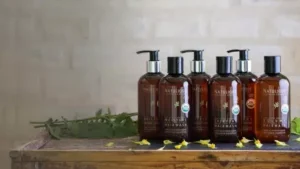Introduction to the mousse effect on curly hair
Understanding the sparkling effect
Foaminess in curly hair is a common phenomenon that many people try to avoid. It occurs when the hair cuticles lift, allowing moisture to penetrate and disrupt the shape of the curls. This leads to a voluminous, untidy appearance, often seen as undesirable by those who prefer defined, well-formed curls. Understanding the causes of this effect is key to knowing how to prevent it.
The importance of avoiding mousse for hair quality
Avoiding mousse is not just a question of aesthetics. It has a direct impact on the health and quality of your curly hair. When hair is well moisturized and protected, it retains its natural elasticity and shine. It also reduces the risk of breakage and helps maintain well-defined curls, increasing the longevity of your favorite hairstyles.
Different types of curly hair and their propensity for mousse effect
There are several types of curly hair, each with a different tendency to develop mousse depending on its structure and thickness.
Fine curly hair
Fine curly hair is particularly vulnerable to mousse. Its light, delicate structure tends to lift easily under the effect of humidity, which can quickly lead to a frothy appearance. To minimize this effect, it's crucial to pay particular attention to moisturizing and to favor lightweight hair products to avoid weighing down the hair fiber.
Thick curly hair
Thick curly hair, on the other hand, although more resistant, is not exempt from this phenomenon. Their natural weight can sometimes help to contain the mousse effect, but when this hair lacks moisture or is exposed to high humidity conditions, the mousse effect can appear. The use of rich, nourishing products adapted to thick hair is essential to combat this problem.
Techniques and strategies to avoid foaming
Adopt the right washing and drying techniques
Moderate use of shampoo
One of the keys to preventing mousse is to use shampoo sparingly. We recommend washing curly hair every 2 to 3 days to avoid stripping hair of its natural oils. Opting for a sulfate-free shampoo is also crucial, as it cleanses gently without damaging the hair fiber. Gentle cleansing maintains hair's natural moisture and reduces the appearance of mousse.
Gentle drying to prevent foaming
Drying curly hair requires special care to avoid disturbing the curls. Wrap your hair in a microfiber towel or soft cotton T-shirt, avoiding the friction that promotes mousse. When using a hairdryer, opt for a low-temperature, low-speed diffuser nozzle to preserve curl definition and minimize the mousse effect.
Use products adapted to curly hair
Moisturizing cream
The regular application of a moisturizing cream for curly hair is essential to combat mousse. These creams help maintain hair moisture and define curls. Choose light formulas for fine hair and richer products for thicker hair, so as not to weigh hair down while still providing sufficient moisture.
Essential oils
Essential oils, such as argan or coconut oil, are excellent allies in the fight against mousse. They deeply nourish the hair fiber and create a barrier against humidity. Use a few drops on damp or dry hair, concentrating on the ends to seal in moisture and protect your curls from external aggressors.
Adopt appropriate hairstyles to prevent mousse effect
Hairstyles that limit the mousse effect
Opting for hairstyles that minimize the risk of mousse is an excellent strategy for curly hair. Loose braids or a low bun can help retain moisture and protect curls from friction. These styles protect hair from ambient humidity while offering an elegant look.
Curl-friendly styling techniques
Using the right techniques is essential to preserve the integrity of your curls. For example, avoid combing your hair when it's dry. Instead, use a wide-tooth comb or your fingers when hair is still damp to gently detangle without breaking the natural structure of curls. Gentle gestures reduce the risk of frothy hair, ensuring well-shaped curls full of vitality.
See also: How to add volume with a hair wax?
Precautions
Protection against environmental elements
Curly hair is particularly sensitive to environmental elements, including wind, sun and humidity. To avoid a frothy effect, it's essential to protect your hair when you're outdoors. Wearing a hat or using a scarf to cover your hair can be very beneficial. These accessories can help avoid sun damage and reduce exposure to weather conditions that promote mousse.
Use of products with UV protection
Incorporating hair care with UV protection into your routine can make a big difference. UV rays can dry out curls, causing loss of definition and accentuating mousse. Choose hair care products that contain sunscreens to effectively protect your hair. A sun protection spray can be applied before going out, to ensure your curls stay as healthy and hydrated as possible.
Internal hydration
Hair hydration starts from the inside. Make sure you drink enough water throughout the day to keep your body and hair well hydrated. A diet rich in essential vitamins and minerals, such as vitamin E, zinc and omega-3 fatty acids, can also promote healthy hair. These nutrients help strengthen the hair fiber and reduce mousse by improving the texture and resilience of your curls.
Nutrient supplementation
Consider nutritional supplements if necessary to make up for dietary deficiencies. Supplements containing biotin, iron and vitamin D are known to promote healthy hair. Consult a healthcare professional to determine which supplements may be beneficial for you. An optimal nutritional balance can significantly improve the appearance and health of your curls.
Choosing hair accessories
The accessories you use to style your hair can have an impact on the mousse effect. Choose non-metallic elastics and clips to tie your hair, which minimize breakage and abrasion of the hair fiber. Avoid accessories that pull or damage hair, and opt for those that promote softness and hold without adding stress to curls.
Avoid plastic accessories
Plastic accessories can generate static electricity, contributing to foaming. Opt for natural or fabric-covered accessories to minimize this risk. Silk or satin bands are also excellent choices for preserving the integrity and care of curls while adding an elegant touch to your hairstyles.
Night-time routine
Before going to bed, adopt a care routine aimed at minimizing the mousse effect. Tie your hair into a loose pineapple with a soft elastic to keep curls in place while you sleep. Use a satin or silk pillowcase to reduce friction, which can lead to mousse when you wake up.
Night-time hydration
Apply a light moisturizing spray or a few drops of hair oil before bed to maintain moisture overnight. This helps keep your curls supple and ready for morning styling, reducing the appearance of flyaways and unwanted mousse.
- UV protection and silk accessories
- Supplementation for healthy hair
- Moisturizing night routine
Environment and lifestyle to prevent foaming
Influence of climatic conditions
Humidity and curly hair
Moisture is one of the main factors contributing to the mousse effect. It penetrates the hair cuticle, disrupting its natural shape. To counteract this, we recommend using a humidity protector before going out. These products help create a barrier that prevents humidity from affecting your curls, allowing them to remain well-defined even in humid weather.
Dry climate
In dry climates, lack of moisture can also be problematic for curly hair, causing dryness and breakage. Properly moisturizing your hair with treatments enriched with aloe vera or hyaluronic acid can be beneficial. These ingredients help retain water in the hair fiber, preventing your curls from becoming dull and mousse-like.
The impact of lifestyle on curly hair
Stress management
Stress can affect not only your overall health, but also the quality of your hair. High stress levels can lead to increased cortisol production, which has a negative impact on hair structure. Practicing relaxing activities such as yoga or meditation can help reduce stress, improving the appearance and health of your curly hair.
A balanced diet
A diet rich in essential nutrients is crucial for healthy hair. Make sure you include enough protein, vitamins and minerals in your diet. Protein fortifies keratin, the main component of hair, while vitamins and minerals promote the growth and strengthening of curls.
Influence of cultural practices
Traditional rituals
Cultural practices and traditional rituals can offer natural solutions to the problem of mousse. For example, using herbal infusions such as rosemary or green tea when rinsing can strengthen hair and reduce its fragility in the face of humidity. Incorporating these approaches into your hair routine can not only reduce mousse but also enrich the care experience for your curly hair.
FAQ about mousse and curly hair
What type of hairstyle is best for avoiding mousse?
Low buns and loose braids are ideal, as they protect hair from humidity while reducing friction.
Are natural hair products effective against mousse?
Yes, natural products like vegetable oils and moisturizers can help nourish and protect curly hair from humidity.
How can I avoid foaming during exercise?
Tie your hair in a pineapple or high bun to limit handling, and use an absorbent headband to manage perspiration.
Can heat aggravate the foaming effect?
Yes, excessive use of heat tools can dry out hair, accentuating the mousse effect. Always use a thermal protector.
Should I avoid certain ingredients in my hair care products?
Sulfates and parabens are ingredients to be avoided as they can strip hair of its natural oils, making it more likely to become frothy.





